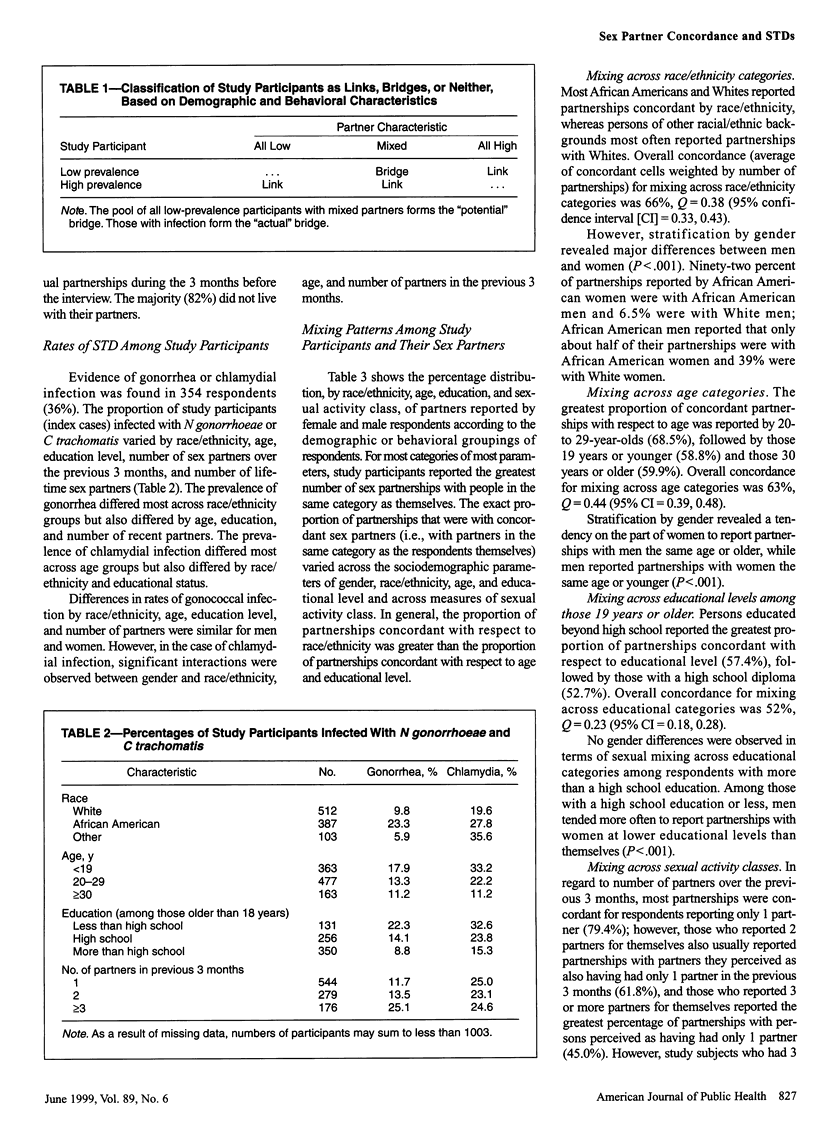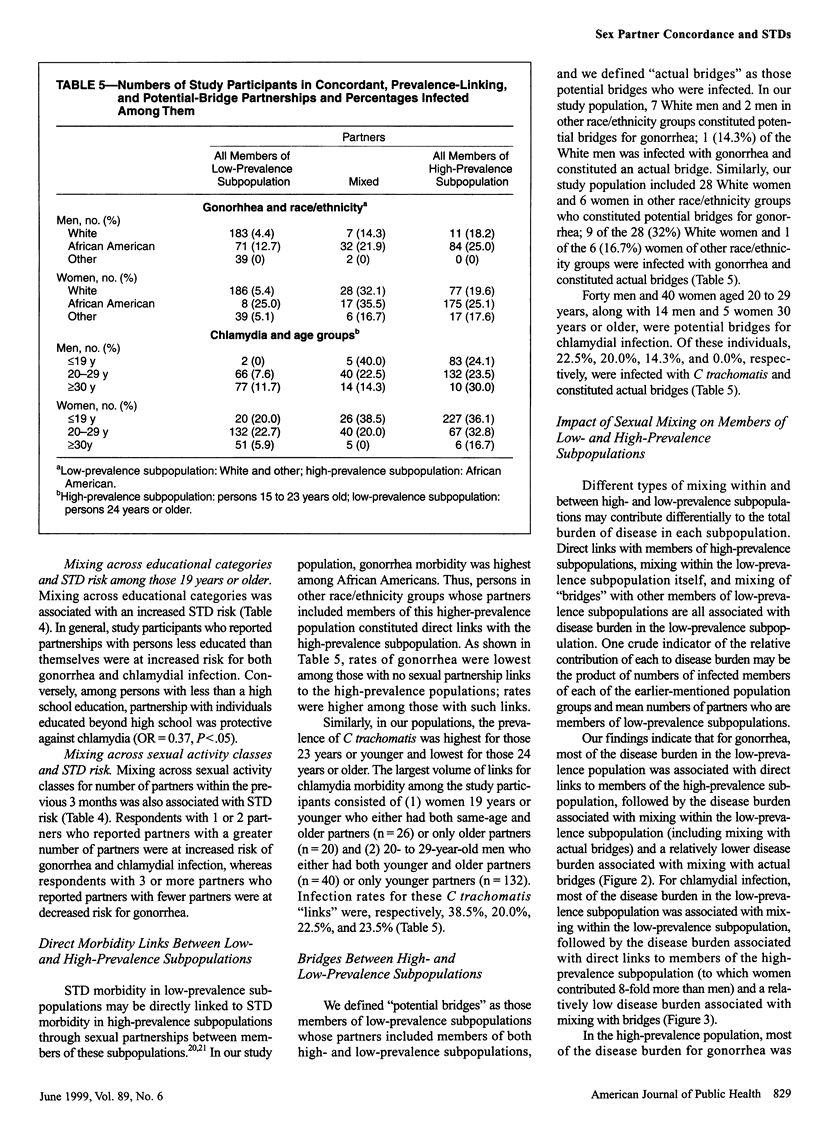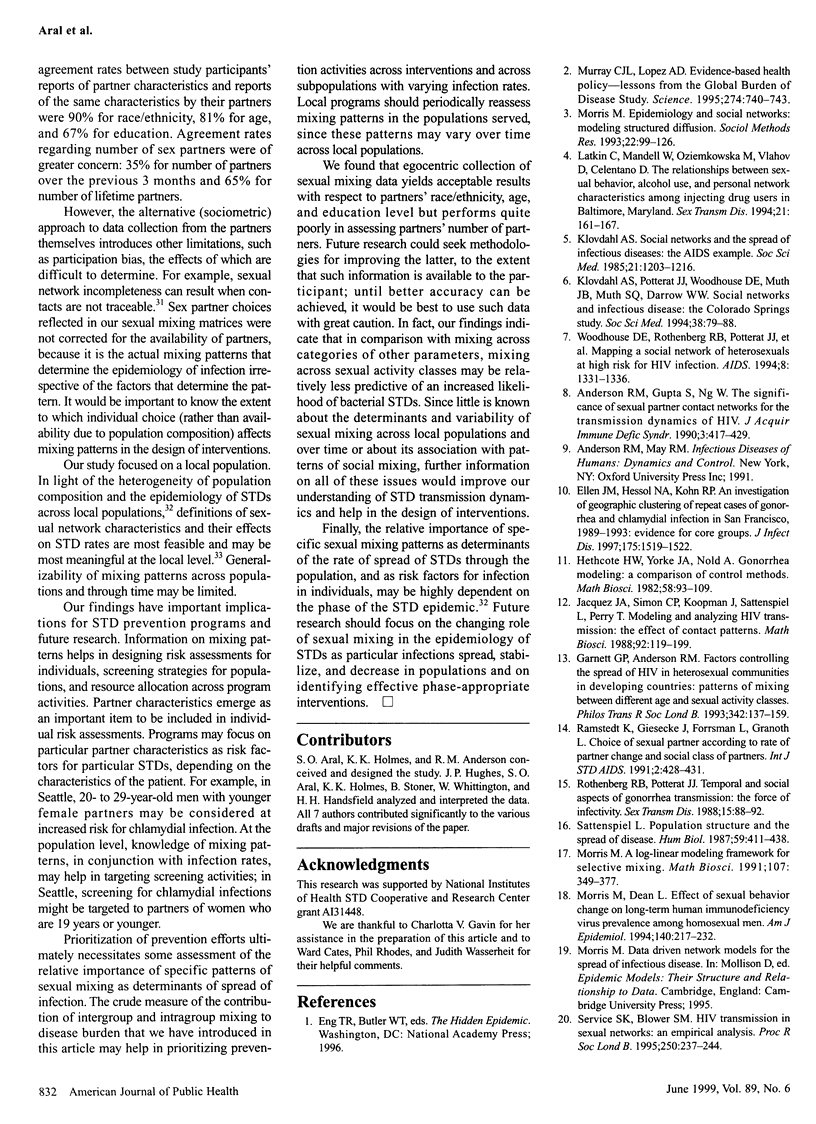Abstract
OBJECTIVES: This study sought to define, among sexually transmitted disease (STD) clinic attendees, (1) patterns of sex partner selection, (2) relative risks for gonococcal or chlamydial infection associated with each mixing pattern, and (3) selected links and potential and actual bridge populations. METHODS: Mixing matrices were computed based on characteristics of the study participants and their partners. Risk of infection was determined in study participants with various types of partners, and odds ratios were used to estimate relative risk of infection for discordant vs concordant partnerships. RESULTS: Partnerships discordant in terms of race/ethnicity, age, education, and number of partners were associated with significant risk for gonorrhea and chlamydial infection. In low-prevalence subpopulations, within-subpopulation mixing was associated with chlamydial infection, and direct links with high-prevalence subpopulations were associated with gonorrhea. CONCLUSIONS: Mixing patterns influence the risk of specific infections, and they should be included in risk assessments for individuals and in the design of screening, health education, and partner notification strategies for populations.
Full text
PDF








Selected References
These references are in PubMed. This may not be the complete list of references from this article.
- Anderson R. M., Gupta S., Ng W. The significance of sexual partner contact networks for the transmission dynamics of HIV. J Acquir Immune Defic Syndr. 1990;3(4):417–429. [PubMed] [Google Scholar]
- Ellen J. M., Hessol N. A., Kohn R. P., Bolan G. A. An investigation of geographic clustering of repeat cases of gonorrhea and chlamydial infection in San Francisco, 1989-1993: evidence for core groups. J Infect Dis. 1997 Jun;175(6):1519–1522. doi: 10.1086/516491. [DOI] [PubMed] [Google Scholar]
- Garnett G. P., Anderson R. M. Factors controlling the spread of HIV in heterosexual communities in developing countries: patterns of mixing between different age and sexual activity classes. Philos Trans R Soc Lond B Biol Sci. 1993 Oct 29;342(1300):137–159. doi: 10.1098/rstb.1993.0143. [DOI] [PubMed] [Google Scholar]
- Garnett G. P., Hughes J. P., Anderson R. M., Stoner B. P., Aral S. O., Whittington W. L., Handsfield H. H., Holmes K. K. Sexual mixing patterns of patients attending sexually transmitted diseases clinics. Sex Transm Dis. 1996 May-Jun;23(3):248–257. doi: 10.1097/00007435-199605000-00015. [DOI] [PubMed] [Google Scholar]
- Ghani A. C., Swinton J., Garnett G. P. The role of sexual partnership networks in the epidemiology of gonorrhea. Sex Transm Dis. 1997 Jan;24(1):45–56. doi: 10.1097/00007435-199701000-00009. [DOI] [PubMed] [Google Scholar]
- Granath F., Giesecke J., Scalia-Tomba G., Ramstedt K., Forssman L. Estimation of a preference matrix for women's choice of male sexual partner according to rate of partner change, using partner notification data. Math Biosci. 1991 Dec;107(2):341–348. doi: 10.1016/0025-5564(91)90013-9. [DOI] [PubMed] [Google Scholar]
- Gupta S., Anderson R. M., May R. M. Networks of sexual contacts: implications for the pattern of spread of HIV. AIDS. 1989 Dec;3(12):807–817. [PubMed] [Google Scholar]
- Klovdahl A. S., Potterat J. J., Woodhouse D. E., Muth J. B., Muth S. Q., Darrow W. W. Social networks and infectious disease: the Colorado Springs Study. Soc Sci Med. 1994 Jan;38(1):79–88. doi: 10.1016/0277-9536(94)90302-6. [DOI] [PubMed] [Google Scholar]
- Klovdahl A. S. Social networks and the spread of infectious diseases: the AIDS example. Soc Sci Med. 1985;21(11):1203–1216. doi: 10.1016/0277-9536(85)90269-2. [DOI] [PubMed] [Google Scholar]
- Latkin C., Mandell W., Oziemkowska M., Vlahov D., Celentano D. The relationships between sexual behavior, alcohol use, and personal network characteristics among injecting drug users in Baltimore, Maryland. Sex Transm Dis. 1994 May-Jun;21(3):161–167. doi: 10.1097/00007435-199405000-00006. [DOI] [PubMed] [Google Scholar]
- Morris M. A log-linear modeling framework for selective mixing. Math Biosci. 1991 Dec;107(2):349–377. doi: 10.1016/0025-5564(91)90014-a. [DOI] [PubMed] [Google Scholar]
- Morris M., Dean L. Effect of sexual behavior change on long-term human immunodeficiency virus prevalence among homosexual men. Am J Epidemiol. 1994 Aug 1;140(3):217–232. doi: 10.1093/oxfordjournals.aje.a117241. [DOI] [PubMed] [Google Scholar]
- Morris M., Podhisita C., Wawer M. J., Handcock M. S. Bridge populations in the spread of HIV/AIDS in Thailand. AIDS. 1996 Sep;10(11):1265–1271. doi: 10.1097/00002030-199609000-00013. [DOI] [PubMed] [Google Scholar]
- Murray C. J., Lopez A. D. Evidence-based health policy--lessons from the Global Burden of Disease Study. Science. 1996 Nov 1;274(5288):740–743. doi: 10.1126/science.274.5288.740. [DOI] [PubMed] [Google Scholar]
- Potterat J. J., Rothenberg R. B., Woodhouse D. E., Muth J. B., Pratts C. I., Fogle J. S., 2nd Gonorrhea as a social disease. Sex Transm Dis. 1985 Jan-Mar;12(1):25–32. doi: 10.1097/00007435-198501000-00006. [DOI] [PubMed] [Google Scholar]
- Ramstedt K., Giesecke J., Forssman L., Granath F. Choice of sexual partner according to rate of partner change and social class of the partners. Int J STD AIDS. 1991 Nov-Dec;2(6):428–431. doi: 10.1177/095646249100200607. [DOI] [PubMed] [Google Scholar]
- Rothenberg R. B., Potterat J. J. Temporal and social aspects of gonorrhea transmission: the force of infectivity. Sex Transm Dis. 1988 Apr-Jun;15(2):88–92. doi: 10.1097/00007435-198804000-00004. [DOI] [PubMed] [Google Scholar]
- Rothenberg R. B. The geography of gonorrhea. Empirical demonstration of core group transmission. Am J Epidemiol. 1983 Jun;117(6):688–694. doi: 10.1093/oxfordjournals.aje.a113602. [DOI] [PubMed] [Google Scholar]
- Sattenspiel L. Population structure and the spread of disease. Hum Biol. 1987 Jun;59(3):411–438. [PubMed] [Google Scholar]
- Service S. k., Blower S. M. HIV transmission in sexual networks: an empirical analysis. Proc Biol Sci. 1995 Jun 22;260(1359):237–244. doi: 10.1098/rspb.1995.0086. [DOI] [PubMed] [Google Scholar]
- Wasserheit J. N., Aral S. O. The dynamic topology of sexually transmitted disease epidemics: implications for prevention strategies. J Infect Dis. 1996 Oct;174 (Suppl 2):S201–S213. doi: 10.1093/infdis/174.supplement_2.s201. [DOI] [PubMed] [Google Scholar]
- Woodhouse D. E., Rothenberg R. B., Potterat J. J., Darrow W. W., Muth S. Q., Klovdahl A. S., Zimmerman H. P., Rogers H. L., Maldonado T. S., Muth J. B. Mapping a social network of heterosexuals at high risk for HIV infection. AIDS. 1994 Sep;8(9):1331–1336. doi: 10.1097/00002030-199409000-00018. [DOI] [PubMed] [Google Scholar]


